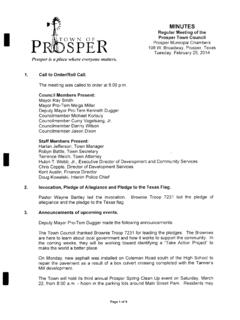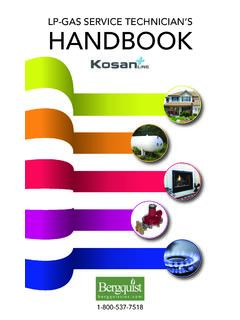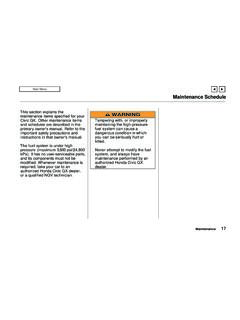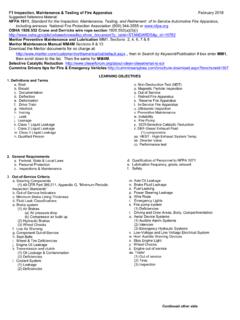Transcription of IFC/NFPA/NEC Guide to Fire Alarm Wiring & Box Installations
1 Prosper Fire Department 1500 E. First Street Prosper, Texas 75078 972-347-2424 Phone 972-347-3010 Fax Rev. 02-17 Subject to Change IFC/NFPA/NEC Guide to Fire Alarm Wiring & Box Installations There are many factors to consider when installing fire Alarm wire, raceways, boxes & cabinets comprising a fire Alarm system. Construction type Type IA Type IB Type IIA Type IIB Type III Type IV Type V Environments Environments are wide ranging and too numerous to identify. Please consult the International Building Code. The basic principles enforced as prescribed in the national codes & standards to consider a) IFC-2012, General Authority and Responsibilities b) Texas Insurance Code Chapter 6002 (formerly Article ) Fire Detection and Alarm Device Installation and 28 TAC The Fire Alarm Rules c) The NEC, Chapter 1, Article 100 Definitions d) The NEC, Chapter 3, Section Protection from Physical Damage e) The NEC, Chapter 3, Section 314 Device, Pull & Junction Boxes f) The NEC, Chapter 7, Section Mechanical Execution of Work g)
2 The NEC, Chapter 7, Section - Wiring Methods and Materials on the Load Side of the PLFA Power Source The following are specific items that an installer may encounter when installing fire Alarm wire, raceways, boxes & cabinets comprising a fire Alarm system. I. Requirements for Electrical Installations Spaces about Electrical Equipment. Access and working space shall be provided and maintained about all electrical equipment to permit ready and safe operation and maintenance of such equipment. (1) Depth of Working Space. The depth of the working space in the direction of live parts shall not be less than that specified in Table (A) (1) unless the requirements of (A) (1)(a), (A) (1)(b), or (A) (1)(c) are met.
3 Distances shall be measured from the exposed live parts or from the enclosure or opening if the live parts are enclosed. (2) Width of Working Space. The width of the working space in front of the electrical equipment shall be the width of the equipment or 762 mm (30 in.), whichever is greater. In all cases, the workspace shall permit at least a 90-degree opening of equipment doors or hinged panels. (3) Height of Working Space. The work space shall be clear and extend from the grade, floor, or platform to a height of m (61 2 ft.) or the height of the equipment, whichever is greater.
4 Within the height requirements of this section, other equipment that is associated with the electrical installation and is located above or below the electrical equipment shall be permitted to extend not more than 150 mm (6 in.) beyond the front of the electrical equipment. nfpa 72 Chapter 10 Fundamentals Equipment shall be designed so that it is capable of performing its intended functions under the following conditions: (1)*At 85 percent and at 110 percent of the nameplate primary (main) and secondary (standby) input voltage(s) (2) At ambient temperatures of 0 C (32 F) and 49 C (120 F) (3) At a relative humidity of 85 percent and an ambient temperature of 30 C (86 F) Installation and Design.
5 * All systems shall be installed in accordance with the specifications and standards approved by the authority having jurisdiction. Equipment shall be installed in locations where conditions do not exceed the voltage, temperature, and humidity limits specified in the manufacturer s published instructions. Personnel Qualifications. System Designer. Fire Alarm system and emergency communications system plans and specifications shall be developed in accordance with this Code by persons who are experienced in the proper design, application, installation, and testing of the systems.
6 State or local licensure regulations shall be followed to determine qualified personnel. The system designer shall provide evidence of their qualifications and/or certifications when required by the authority having jurisdiction. System Installer. Fire Alarm systems and emergency communications systems installation personnel shall be qualified or shall be supervised by persons who are qualified in the installation, inspection, and testing of the systems. State or local licensure regulations shall be followed to determine qualified personnel.
7 The system installer shall provide evidence of their qualifications and/or certifications when requested by the authority having jurisdiction. Sales, Installation, and Service. (1) The installation of all fire detection and fire Alarm devices or systems, including monitoring equipment, subject to Insurance Code Chapter 6002 must be performed by or under the direct on -site supervision of a licensed fire Alarm technician , residential fire Alarm technician , residential fire Alarm superintendent, or a fire Alarm planning superintendent for the work permitted by the license.
8 The licensee responsible for the planning of all fire detection and fire Alarm devices or systems, including monitoring equipment subject to Insurance Code Chapter 6002, must be licensed under the ACR number of the primary licensed firm. The certifying licensee must be licensed under the ACR number of the primary registered firm and must be present for the final acceptance test prior to certification. II. Protection against Physical Damage nfpa 70 section - Where subject to physical damage, conductors, raceways, and cables shall be protected. Underground Installations .
9 (A) Minimum Cover Requirements. Direct-buried cable or conduit or other raceways shall be installed to meet the minimum cover requirements of Table (B) Wet Locations. The interior of enclosures or raceways installed underground shall be considered a wet location. Insulated conductors and cables installed in these enclosures or raceways in underground Installations shall comply with (C). Any connections or splices in an underground installation shall be approved for wet locations. Securing and Supporting (A) Secured in Place. Raceways, cable assemblies, boxes, cabinets, and fittings shall be securely fastened in place.
10 Support wires that do not provide secure support shall not be permitted as the sole support. Support wires and associated fittings that provide secure support and that are installed in addition to the ceiling grid support wires shall be permitted as the sole support. Where independent support wires are used, they shall be secured at both ends. Cables and raceways shall not be supported by ceiling grids. (1) Fire-Rated Assemblies. Wiring located within the cavity of a fire-rated floor ceiling or roof ceiling assembly shall not be secured to, or supported by, the ceiling assembly, including the ceiling support wires.









